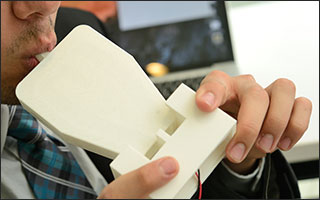In developing nations of the world, as many as 200 million women want access to long-term, reversible contraceptives. A convenient and effective option comes in the form of a tiny, removable subdermal contraceptive implant. The matchstick-sized implant can delay conception for three to five years — and then be removed when fertility is desired.
Where health care is limited, the implant and removal procedures must be performed by frontline providers, such as midwives or nurses. The result can be that the small implant may be inadvertently inserted into the woman’s fat tissue instead of just under the outer skin layer. This not only causes the contraceptive to be ineffective, but makes removal of the implant far more difficult.
To remedy this problem, a team of Johns Hopkins biomedical engineering undergraduates has developed the Contraceptive Implant Training Tool Kit, or CITT Kit. Their training kit includes an arm-like practice band made of differing densities of silicon layers. These layers accurately simulate the anatomical textures of skin, fat, and muscle in a human arm. The CITT Kit also provides components that can help the trainees identify the correct placement site for the subdermal implant. It also enables the clinician to make practice incisions through replaceable silicone layers that respond more like human skin — particularly useful in the more difficult removal procedure.
“In designing these teaching tools, every choice we made was to pursue biofidelity, trying to prepare the health workers as closely as possible for the conditions they’ll face when they actually perform these procedures in a clinic,” said Miguel Sobral, a sophomore team member from Lisbon, Portugal.
The subdermal contraceptive implant needs to be inserted just under the outermost skin layer, about 4 inches above the elbow, where it can slowly secrete a hormone that temporarily blocks conception. Compared to existing simulation devices, this kit provides superior training in the safe removal of an implant — which is typically a procedure that’s considered to be more challenging than insertion of the contraceptive.
The BME student designers showcased their device at the annual Johns Hopkins Biomedical Engineering Design Day event, organized by the university’s Center for Bioengineering Innovation and Design. The CITT Kit was developed within the yearlong undergraduate design team program directed by Robert H. Allen, an associate research professor in the Department of Biomedical Engineering and the Johns Hopkins School of Medicine’s Department of Gynecology and Obstetrics. They were advised by physician Ricky Lu, technical director for reproductive health and family planning at Jhpiego, a nonprofit Johns Hopkins University affiliate that focuses on global health issues involving women and families.

